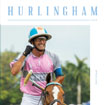 Polo is thought to have originated in China and Persia around 2,000 years ago. The name of the game may well come from the word “pholo” meaning ‘ball’ or ‘ballgame’ in the Balti language of Tibet. The first recorded game took place in 600BC between the Turkomans and Persians (the Turkomans won). In the fourth century AD, King Sapoor II of Persia learned to play, aged seven. In the 16th century, a polo ground (300 yards long and with goalposts eight yards apart) was built at Ispahan, then the capital, by Shah Abbas the Great.
Polo is thought to have originated in China and Persia around 2,000 years ago. The name of the game may well come from the word “pholo” meaning ‘ball’ or ‘ballgame’ in the Balti language of Tibet. The first recorded game took place in 600BC between the Turkomans and Persians (the Turkomans won). In the fourth century AD, King Sapoor II of Persia learned to play, aged seven. In the 16th century, a polo ground (300 yards long and with goalposts eight yards apart) was built at Ispahan, then the capital, by Shah Abbas the Great.
The Moguls were largely responsible for taking the game from Persia to the east and, by the 16th century, the Emperor Babur had established it in India. (It had already long been played in China and Japan, but had died out by the time the West came in contact with those countries).
In the 1850s, British tea planters discovered the game in Manipur (Munipoor) on the Burmese border with India. They founded the world’s first polo club at Silchar, west of Manipur. Other clubs followed and today the oldest in the world is the Calcutta Club which founded in 1862. Malta followed in 1868 because soldiers and naval officers stopped off there on their way home from India. In 1869, Edward “Chicken” Hartopp, of the 10th Hussars, read an account of the game in The Field magazine while stationed at Aldershot and, with fellow officers, organised the first game.
Then known as “hockey on horseback,” it was played on a hastily-rolled Hounslow Heath where a shortlist of about 10 rules was also hastily assembled. But, it was John Watson (1856-1908), of the 13th Hussars, who formulated the first real rules of the game in India in the 1870s. He later formed the celebrated Freebooters team who won the first Westchester Cup match in 1886. He was a key player at the All Ireland Polo Club which was founded in 1872 by Horace Rochfort of Clogrenane, County Carlow.
The first polo club in England was Monmouthshire, founded in 1872 by Captain Francis “Tip” Herbert (1845- 1922), of the 7th Lancers, at his brother’s estate at Clytha Park, near Abergavenny. Others, including Hurlingham, followed quickly. Handicaps were introduced by the USA in 1888 and by England and India in 1910. The first official match in Argentina took place on 3rd September 1875. The game had been taken there by English and Irish engineers and ranchers.
In 1876, Lt Col Thomas St.Quintin, of the 10th Hussars, introduced the game to Australia. He is credited with being the Father of Australian Polo. Two of his brothers stayed on there as ranchers and helped the game to develop. In the same year, polo was introduced to the USA by James Gordon Bennett Junior who had seen the game at Hurlingham during a visit to England. Today, more than 77 countries play polo. It was an Olympic sport from 1900 to 1939 and has now been recognised again by the International Olympic Committee.
The history of Polo at a glance
600 BC. The first recorded game took place between the Turkomans and Persians (the Turkomans won).
4th century AD.King Sapoor II of Persia learned to play, aged 7.
7th century AD. Polo spreads from China to Japan
16th century AD. A polo ground (300 yards long and with goal posts 8 yards apart) was built at Ispahan, then the capital, by Shah Abbas the Great. The Moguls were largely responsible for taking the game from Persia to the east and by the 16th century the Emperor Babur had established it in India. Polo was revived in Japan by the 8th Shogun, Tokugawa Yoshimune (1684-1751) and was played until early 20th century. It was the favourite sport of the last Shogun who surrendered power to the Emperor in 1868.
1850s. British tea planters discovered the game in Manipur (Munipoor) on the Burmese border with India.
1862. The first polo club in the world was formed by British tea planters at Silchar, west of Manipur. Calcutta Polo Club, the oldest existing polo club, was founded.
1868. Malta Polo Club founded due mainly to army and naval officers stopping off there on their way home from India.
1869. Edward “Chicken” Hartopp, 10th Hussars, read an account of the game in The Field, while stationed at Aldershot, and, with brother officers, organised the first game – known then as “hockey on horseback”- on a hastily-rolled Hounslow Heath against The 9th Lancers. The 1st Life Guards and the Royal Horse Guards were quick to follow suit on grounds at Hounslow and in Richmond Park; and then on a small ground near Earl’s Court known as Lillie Bridge.
1872. The first polo club in England was Monmouthshire, founded by Capt. Francis “Tip” Herbert (1845 – 1922), 7th Lancers, at his brother’s seat, Clytha Park, near Abergavenny. All Ireland Polo Club was also founded in 1872 by Horace Rochfort of Clogrenane, Co. Carlow.
1875. The first official match in Argentina took place on 3rd September, where the game had been taken by English and Irish engineers and ranchers.
1876. Lt. Col. Thomas St. Quintin, 10th Hussars, introduced the game to Australia – he was the “Father of Australian Polo” and two of his brothers stayed on there as ranchers and helped the game to develop. In the same year, polo was introduced to the U.S.A. by James Gordon Bennett Jr, who had seen the game at Hurlingham while on a visit to England.
1888. Handicaps were introduced in America
1895. The height for polo ponies was raised from 14 hands to 14.2.
1910. Handicaps were introduced in England and India.
1919. Height restriction on polo ponies was abolished.
Today, upwards of 77 countries play polo. It was an Olympic sport from 1900 to 1939 and has now been recognised again by the International Olympic Committee.


